The legal industry has witnessed a remarkable transformation over the past decade, with artificial intelligence evolving from simple rule-based systems to sophisticated tools capable of handling complex legal tasks. A new paradigm is emerging: meta-agents. These advanced AI systems represent a significant leap beyond traditional AI applications, offering unprecedented capabilities for legal professionals. Gartner predicts that by 2028, 33% of enterprise software applications will integrate agentic AI, a substantial increase from less than 1% in 2024.
While traditional AI tools have already revolutionized document review, contract analysis, and legal research, meta-agents are redefining what’s possible by orchestrating multiple AI systems simultaneously, making autonomous decisions, and continuously learning from their interactions. This shift isn’t merely incremental—it represents a fundamental change in how technology supports legal work.
For legal departments and law firms navigating this rapidly evolving landscape, understanding the distinction between traditional AI and meta-agents is crucial for making informed technology investments and staying competitive in an increasingly tech-driven legal environment.
Understanding Traditional AI in Legal Applications
Traditional AI systems in legal settings typically fall into several established categories that have become familiar fixtures in modern law practice:
Document Review and Analysis
Traditional AI excels at reviewing contracts and legal documents to identify specific clauses, potential risks, or anomalies. These systems use natural language processing (NLP) and machine learning algorithms trained on legal text to recognize patterns and extract relevant information. However, this traditional NLP method requires significantly more resources and time for both the initial training and ongoing maintenance based on variations of language that will present over time. With GenAI, the increased true contextual understanding of language goes beyond similarity and keyword matching—which speeds up training time and also simplifies to the point of democratization in the sense that you don’t need to be a machine learning expert to train it, and it’s more a case of prompt engineering.
Legal Research Assistants
AI-powered research tools can search vast databases of case law, statutes, and legal opinions to find relevant precedents and authorities. These systems typically rely on keyword matching, semantic analysis, and citation networks to retrieve pertinent information.
Contract Management
Traditional AI contract management systems automate the contract lifecycle, from creation to execution and renewal. They can generate standard contracts from templates, flag important dates, and provide basic analytics on contract portfolios.
Predictive Analytics
These tools analyze historical case data to predict litigation outcomes, settlement values, or judicial tendencies. They typically use statistical models and machine learning algorithms to identify patterns in previous cases.
Limitations of Traditional AI in Legal Applications
Despite their value, traditional AI systems face significant constraints:
- Narrow Functionality: Each system typically performs a single function well but operates in isolation from other tools
- Limited Context Understanding: Traditional AI often struggles with nuanced legal language and complex reasoning
- Static Knowledge Base: Most systems require manual updates to incorporate new legal developments
- Human Oversight Requirements: Substantial human review remains necessary to validate AI outputs and handle exceptions
- Fragmented Workflows: Legal professionals must switch between multiple AI tools, leading to inefficiencies and potential information gaps
“Meta-agents represent not just an evolution but a revolution in legal technology—shifting from isolated AI tools to intelligent orchestrators that understand context, make autonomous decisions, and continuously learn.” – Naresh Joshi. Chief Architect, ContractPodAi
Introducing Meta-Agents in Legal Technology
Meta-agents can be thought of as highly skilled individual specialists. They’re great at their individual tasks, but just like in any complex legal workflow, there needs to be collaboration, we may need to pass information and execute multi-step processes. This is where meta-agents come in. They act as intelligent orchestrators, understanding a broader objective and then using the capabilities of individual applications to achieve it.
What Are Meta-Agents?
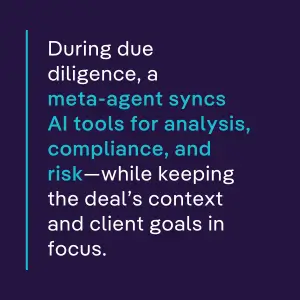
Meta-agents function as intelligent coordinators that oversee and direct multiple AI systems within legal workflows. They can:
- Allocate tasks to specialized AI tools based on their strengths
- Synthesize outputs from various AI systems into coherent recommendations
- Make autonomous decisions about how to route information and tasks
- Learn from outcomes to continuously improve process efficiency
- Maintain context across multiple interactions and documents
For example, in a due diligence scenario, a meta-agent might coordinate document classification AI, contract analysis tools, regulatory compliance checkers, and risk assessment algorithms—all while maintaining awareness of the transaction’s overall context and client priorities.
The Emergence of Meta-Agent Architecture
Meta-agents typically utilize a multi-layered architecture:
- Perception Layer: Interfaces with data sources and users
- Processing Layer: Houses specialized AI tools for specific legal tasks
- Coordination Layer: Manages workflow, task allocation, and information synthesis
- Decision Layer: Makes higher-level judgments about priorities and next steps
- Learning Layer: Continuously improves performance based on outcomes and feedback
This architecture enables meta-agents to handle complex legal processes that previously required extensive human coordination and oversight.
Key Differences Between Meta-Agents and Traditional AI
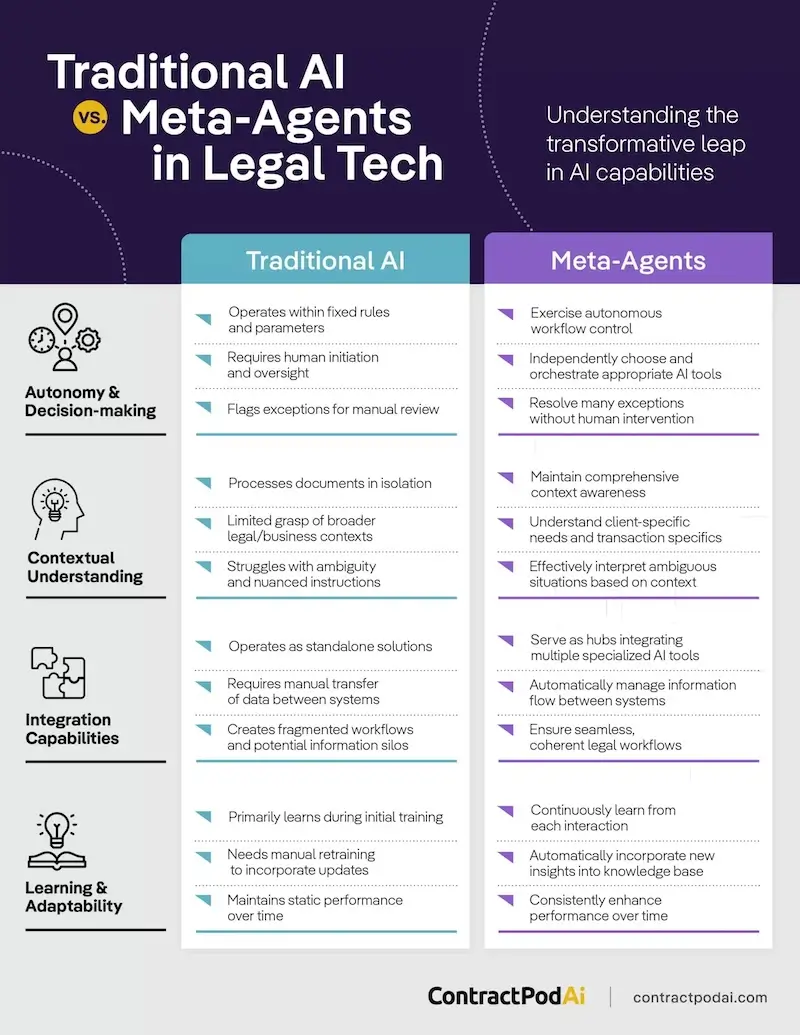
Autonomy and Decision-Making
Traditional AI:
- Operates within strictly defined parameters
- Follows predetermined rules and patterns
- Requires human direction for task initiation and completion
- Handles exceptions by flagging them for human review
Meta-Agents:
- Exercise significant autonomy in determining process workflows
- Make independent decisions about which tools to deploy for specific tasks
- Dynamically adjust processes based on context and emerging information
- Handle many exceptions autonomously through sophisticated reasoning
For example, while a traditional contract analysis AI might flag unusual clauses for human review, a meta-agent could recognize the clause’s purpose, cross-reference it with similar provisions in other agreements, assess its risk profile, and suggest appropriate modifications—all without human intervention.
Adaptability and Learning
Traditional AI:
- Primarily learns during initial training phases
- Requires formal retraining to incorporate new information
- Struggles to transfer knowledge between different legal domains
- Maintains relatively static performance levels over time
Meta-Agents:
- Learn continuously from each interaction and outcome
- Automatically incorporate new information into their knowledge base
- Transfer learnings across different legal processes and domains
- Demonstrate measurable performance improvements over time without manual retraining
This capacity for ongoing learning makes meta-agents particularly valuable for rapidly evolving legal areas, such as cryptocurrency regulation, data privacy law, or emerging environmental compliance requirements.
Integration and Coordination
Traditional AI:
- Function as standalone tools for specific tasks
- Lacks awareness of other systems’ activities
- Requires manual transfer of outputs between systems
- Creates potential information silos within organizations
Meta-Agents:
- Serve as integration hubs for multiple AI systems
- Maintain awareness of all ongoing processes and dependencies
- Automatically route information between appropriate systems
- Ensure consistent knowledge sharing across the organization
This integration capability significantly reduces the fragmentation that has plagued legal technology implementations, where firms often accumulate dozens of disconnected point solutions.
Contextual Understanding
Traditional AI:
- Processes individual documents or queries in isolation
- Limited understanding of broader business or legal context
- Struggles with ambiguous instructions or requirements
- Typically applies universal rules regardless of specific circumstances
Meta-Agents:
- Maintain awareness of entire matter or transaction context
- Understand client-specific priorities and risk tolerances
- Interpret ambiguous requests based on contextual knowledge
- Apply different approaches based on jurisdiction, matter type, or client needs
This enhanced contextual awareness allows meta-agents to deliver more relevant and nuanced support for legal professionals.
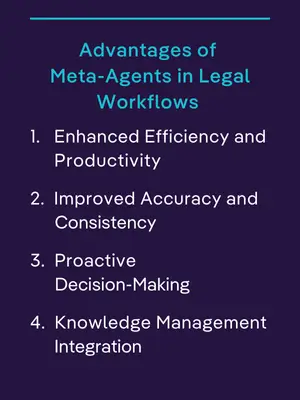
Advantages of Meta-Agents in Legal Workflows
Enhanced Efficiency and Productivity
Meta-agents dramatically streamline legal workflows by:
- Eliminating workflow gaps: Automatically connecting outputs from one process to inputs for another
- Reducing context switching: Allowing legal professionals to interact with a single system rather than multiple tools
- Automating coordination tasks: Handling the routing and prioritization that typically consumes attorney time
- Accelerating complex processes: Running multiple analyses simultaneously rather than sequentially
Improved Accuracy and Consistency
Meta-agents enhance quality by:
- Cross-validating results: Comparing outputs from multiple AI systems to identify inconsistencies
- Maintaining contextual awareness: Ensuring analyses remain aligned with overall matter objectives
- Applying standardized methodologies: Enforcing consistent approaches across similar legal tasks
- Reducing human error: Minimizing manual handoffs between systems where information can be lost
Proactive Decision-Making
Perhaps the most transformative capability of meta-agents is their ability to shift legal work from reactive to proactive:
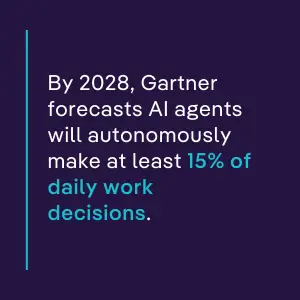
- Anticipating issues: Identifying potential legal problems before they manifest
- Suggesting preventive measures: Recommending contract modifications or compliance adjustments to prevent future disputes
- Monitoring legal developments: Automatically assessing how new cases or regulations affect existing matters
- Identifying optimization opportunities: Suggesting refinements to standard processes based on observed outcomes
For example, a meta-agent might detect an emerging pattern of regulatory enforcement in a particular jurisdiction and proactively recommend changes to compliance processes before any violations occur. By 2028, Gartner forecasts AI agents will autonomously make at least 15% of daily work decisions, enabling legal teams to increasingly rely on intelligent automation to swiftly navigate routine challenges and allowing counsel to focus on higher-value strategic tasks.
Knowledge Management Integration
Meta-agents excel at leveraging institutional knowledge:
- Capturing tacit knowledge: Learning from how attorneys handle similar matters
- Building organizational memory: Maintaining awareness of previous approaches and outcomes
- Enabling knowledge transfer: Making expertise from one practice area available to another
- Supporting institutional continuity: Preserving knowledge despite attorney turnover
This knowledge integration capability helps firms overcome the perennial challenge of “reinventing the wheel” with each new matter.
The Technical Architecture Behind Legal Meta-Agents
Understanding the technical differences helps legal teams evaluate solutions more effectively:
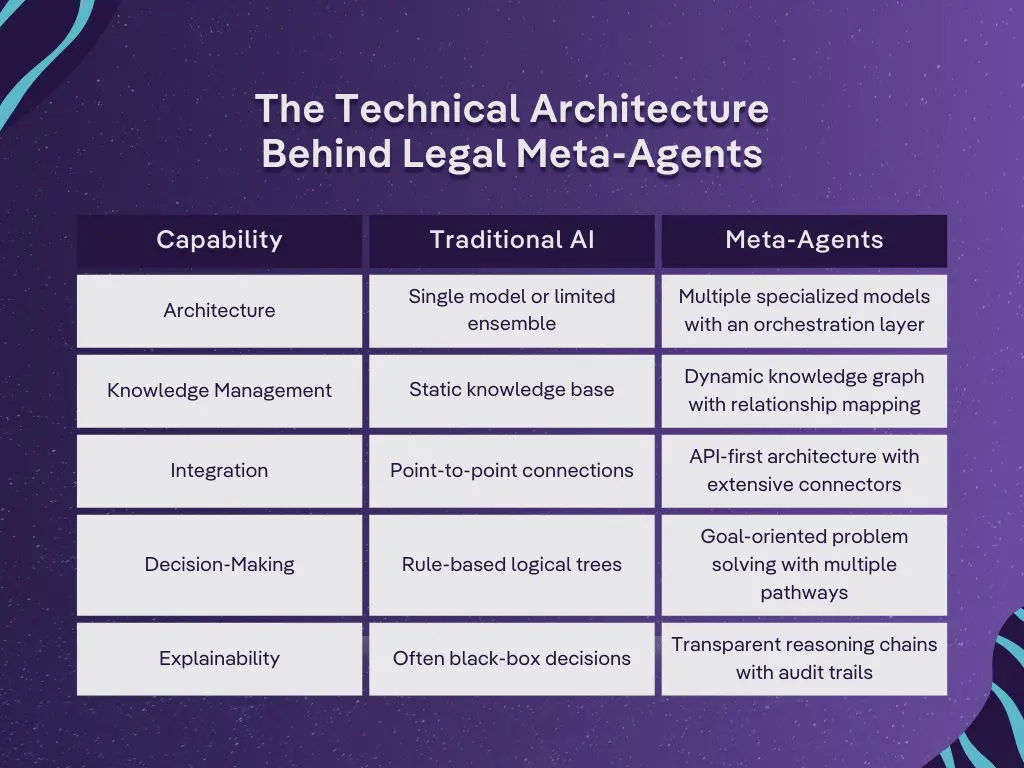
Challenges and Considerations
Implementation Complexity
Deploying meta-agents presents significant challenges:
- System Integration Requirements: Meta-agents must connect with multiple existing systems, each with its own data formats and APIs
- Data Standardization Needs: Organizations often require substantial data cleaning and standardization before meta-agents can function effectively
- Change Management Hurdles: Legal professionals must adapt to significant workflow changes when meta-agents are introduced
- Technical Infrastructure Demands: Meta-agent systems typically require more robust computing resources than traditional AI tools
Successful implementations typically involve phased approaches, starting with limited workflows before expanding to more complex processes.
Performance Optimization and Considerations
To effectively manage complex legal workflows, meta-agents performance optimization techniques within their multi-layered architecture helps them perform better than general AI by:
- Parallel Processing: Meta-agents are designed to simultaneously execute multiple specialized AI tasks, significantly accelerating complex analyses such as document review, contract analysis, and compliance checks
- Dynamic Load Balancing: By intelligently distributing workloads across available computational resources, meta-agents prevent bottlenecks and maintain consistent performance, even during peak usage periods
- Caching and In-Memory Computing: Frequently accessed legal data and insights are cached in memory, enabling rapid retrieval and reducing latency in delivering results
- Optimized Data Pipelines: Meta-agents streamline data ingestion, transformation, and analysis workflows, ensuring efficient processing of large volumes of structured and unstructured legal information
These performance optimization strategies enable meta-agents to deliver robust, scalable, and responsive legal technology solutions, empowering legal professionals to efficiently handle increasingly complex and demanding workloads.
Ethical and Legal Implications
Meta-agents raise important ethical considerations:
- Decision Transparency: The complex reasoning behind meta-agent decisions can be difficult to audit or explain
- Responsibility Attribution: When meta-agents make autonomous decisions, questions arise about who bears responsibility for outcomes
- Data Privacy Concerns: Meta-agents’ access to comprehensive client and matter information intensifies data protection requirements
- Unauthorized Practice of Law Risks: The autonomous capabilities of meta-agents may approach boundaries of what constitutes legal practice
Leading organizations are addressing these concerns through comprehensive governance frameworks that establish clear boundaries for meta-agent authority and mandatory human review thresholds for critical decisions.
Cost and ROI Considerations
Meta-agent systems typically involve:
- Higher initial implementation costs compared to traditional AI tools
- Longer time-to-value as the system learns organizational processes
- Ongoing maintenance and optimization requirements
- Potential need for specialized talent to manage the system
Future Outlook
As we look toward the future of legal technology, several trends suggest meta-agents will become increasingly central to legal practice:
Convergence with Other Technologies
Meta-agents are likely to converge with other emerging technologies, including:
- Blockchain and Smart Contracts: Meta-agents will manage the creation, verification, and execution of smart legal contracts
- Internet of Things (IoT): Legal meta-agents will process real-time data from connected devices to monitor regulatory compliance
- Extended Reality (XR): Meta-agents may facilitate immersive legal collaboration and document visualization
Evolution of Regulatory Frameworks
The legal industry can expect:
- Development of specific standards for explainability and transparency in legal AI systems
- Emerging certification requirements for meta-agents in regulated legal processes
- Industry-specific guidelines for the appropriate use of autonomous legal systems
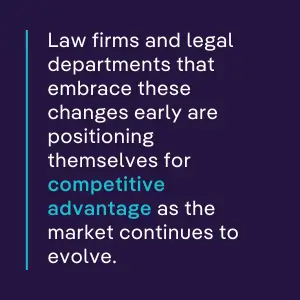
Transformative Impact on Legal Roles
Perhaps most significantly, meta-agents will transform how legal professionals work:
- Attorneys will increasingly focus on strategy, client relationships, and complex reasoning
- New technical-legal hybrid roles will emerge to manage meta-agent systems
- Legal education will evolve to include greater emphasis on technology management
Law firms and legal departments that embrace these changes early are positioning themselves for competitive advantage as the market continues to evolve.
The shift from traditional AI to meta-agents represents a fundamental transformation in legal technology—comparable to the historical transition from individual computers to interconnected networks. While traditional AI tools brought efficiency to specific legal tasks, meta-agents promise to reimagine entire legal workflows through intelligent coordination, autonomous decision-making, and continuous learning.
For legal organizations navigating this rapidly evolving landscape, understanding the capabilities and limitations of meta-agent systems is essential for making strategic technology investments. Those who successfully implement these technologies stand to gain significant advantages in efficiency, accuracy, and client service.
As legal complexity continues to increase amid growing regulatory requirements and global business operations, meta-agents offer a promising path forward—not to replace legal professionals, but to amplify their capabilities and free them to focus on the highest-value aspects of legal practice.
Ready to explore how meta-agents can transform your legal operations? Learn more about ContractPodAi’s cutting-edge AI-driven contract management solutions that incorporate meta-agent technology to streamline your legal workflows and enhance decision-making capabilities.


